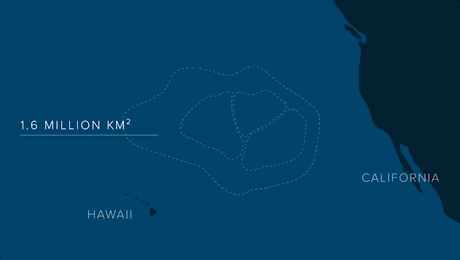In a new study, researchers revealed that the Great Pacific Garbage Patch has grown to over 600,000 square miles.
In a paper published Thursday in the journal Scientific Reports, it was revealed that the Great Pacific Garbage Patch already weighs more than 43,000 cars and is now twice as large as Texas.
This patch is a massive collection of floating trash located between Hawaii and California in the north Pacific Ocean. According to the research analysis from The Ocean Cleanup Foundation led by Laurent Lebreton, the garbage patch reportedly weights 87,000 tons and has over 1.8 trillion pieces of plastic.

“Our model, calibrated with data from multi-vessel and aircraft surveys, predicted at least 79 (45–129) thousand tonnes of ocean plastic are floating inside an area of 1.6 million km2; a figure four to sixteen times higher than previously reported,” the researchers wrote.
For their study, the researchers used a more direct approach to trapping and measuring the Great Pacific Garbage Patch. Instead of trawling the trash with fine nets, the Netherlands-based organization hired 18 ships to trawl at different areas across the patch and used 652 nets capable of trapping not just microplastics but larger trash as well.
Read More: Microplastics Discovered in 93% of Popular Bottled Water Brands
The team also conducted aerial surveys of the patch, covering around 120 square miles and taking over 7,000 pictures to better calculate the number of large plastics present in the area.
They then applied math models and projections of the ocean current to estimate the size of the Great Pacific Garbage Patch.
The researchers’ findings revealed that about 94 percent of the estimated 1.8 trillion plastic pieces in the patch are microplastics. However, these microplastics only amounts to 8 percent of the overall weight of the patch. Apparently, 79,000 metric tons of plastic in the area are mostly fishing nets that were left behind and other forms of detritus.
“I knew there would be a lot of fishing gear, but 46 percent was unexpectedly high,” Lebreton said. “Initially, we thought fishing gear would be more in the 20 percent range. That is the accepted number [for marine debris] globally—20 percent from fishing sources and 80 percent from land.”
On the other hand, Julia Reisser, a member of the Ocean Cleanup Foundation was surprised with the number of ghost nets and large plastics found in GPGP.
“We were surprised by the amount of large plastic objects we encountered,” she went on to say. “We used to think most of the debris consists of small fragments, but this new analysis shines a new light on the scope of the debris.”
Right now, Ocean Cleanup is working on a system that would remove most of the ghost fishing nets from the Great Pacific Garbage Patch. The organization hopes to launch the initiative later this year.








Comments (0)
Most Recent